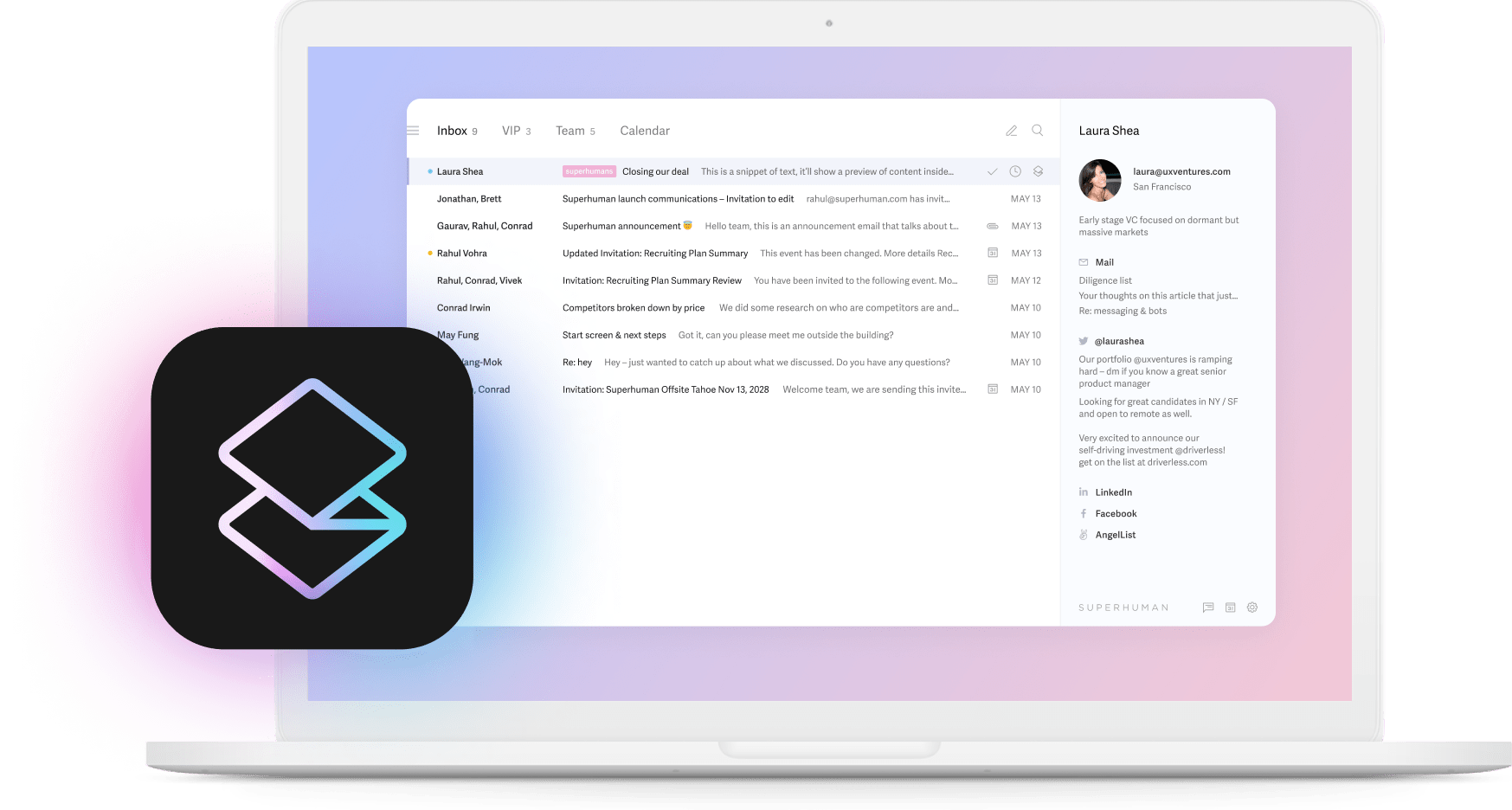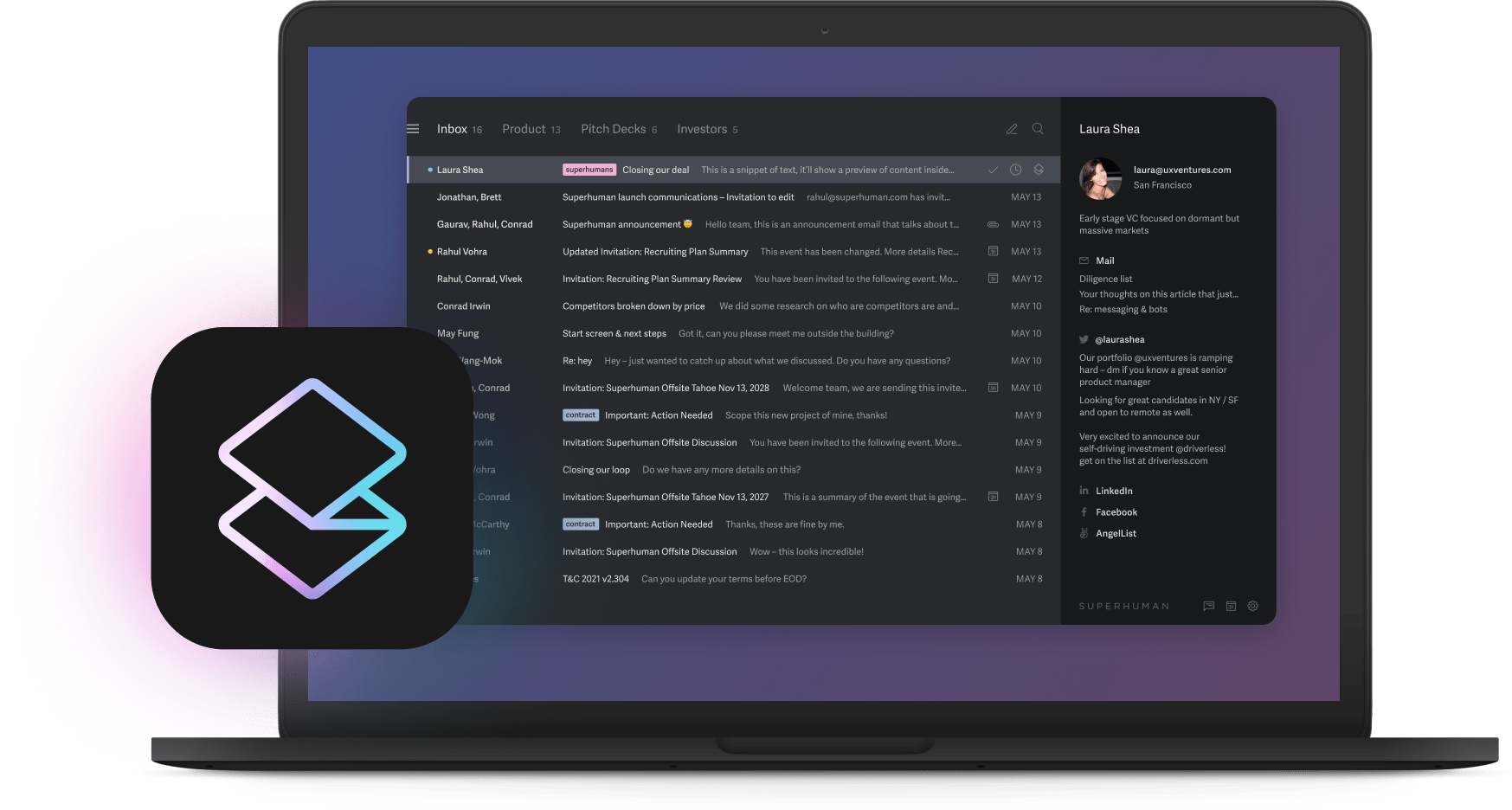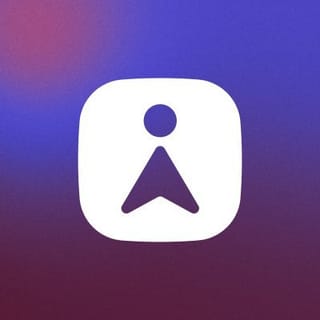
Most remote teams switch between multiple apps per day, and 56% of these workers feel like they have to respond to every notification right away. Yet somehow, everyone's getting less done than before.
You've got Slack for chat, Asana for tasks, Zoom for meetings, Google Drive for files, and email for everything else that doesn't fit anywhere. Sound familiar? Muddled tech stacks like this are slowing you down.
Having more tools doesn't make you more productive. Having the right tools does. Companies like L'Oréal, IBM, and Netflix figured this out. They picked tools that make work easier, not harder.
Here are the exact tools they use, organized by the specific headaches they solve.
For communication and email collaboration
1. Best for integrated communication and AI-native email: Superhuman
Growing companies hit an email breaking point where communication volume overwhelms productivity. Superhuman scales with fast-moving teams by making email coordination effortless.
When your startup goes from 10 to 50 people, email volume explodes but response quality stays consistent. The AI learns how each team member communicates, maintaining personal touch at enterprise scale. You grow faster because communication stays crisp instead of becoming a bottleneck.
What you get and why it matters:
- AI Draft learns your voice: Startup founders spend 3+ hours daily on email, often responding to the same types of investor, customer, and team questions. AI Draft analyzes your previous emails to each person and writes responses that sound exactly like you.
Your investor update gets written in your strategic tone, while your team standup note stays casual and direct. You're not editing robot-speak, you're approving messages that capture your actual communication style.
- Split Inbox prioritizes what matters: Project leaders drown in email noise while urgent client requests get buried. Split Inbox automatically surfaces emails from your team, executives, and key tools like Asana or GitHub at the top.
When a client reports a critical bug at 2 PM, it doesn't get lost under newsletter subscriptions and vendor outreach. You see mission-critical communication first, always.
- Shared Conversations for team decisions: Remote teams struggle with email chains where important decisions happen in individual inboxes. Shared Conversations let your entire team see and contribute to client discussions, vendor negotiations, and strategic planning in real-time.
When a customer requests a feature change, your designer, developer, and product lead all see the thread and can respond with context. No more "forwarding for visibility" or missed stakeholder input.
- Read Statuses eliminate follow-up anxiety: Tech leads send dozens of emails to developers, clients, and stakeholders without knowing if they're being read or ignored. Read Statuses show exactly when someone opened your message and on which device.
When you send a critical security update, you know immediately if your team has seen it. No more wondering if your urgent message disappeared into someone's spam folder.
Try Superhuman2. Best team messaging app: Slack
Moving from email chaos to organized team communication requires the right foundation. Slack transformed how IBM's engineering teams coordinate their work. IBM's teams used to start every day checking for code reviews and remaking processes manually, with senior engineer Thomas Lawless coordinating with 40-50 people across different teams daily.
Now they use Slack as a hub for their entire end-to-end delivery pipeline, from source code to production deployment, with system alerts automatically notifying teams when code needs review.
When incidents occur, teams create dedicated channels that serve as audit trails for post-mortems, capturing all files, screenshots, and discussions in one searchable place. The integration eliminated manual coordination steps and helped teams maintain development pace without constant app switching.
What you get and why it matters:
- Organized channels stop communication chaos: Remote teams often use group chats where urgent project updates get buried under lunch plans and memes. Slack channels create focused spaces for each project, team, and topic.
- Your #product-launch channel contains only launch-related discussions, while #general handles company announcements. When someone needs the final logo approval from last week, they search #design-review instead of scrolling through 500 mixed messages.
- App integrations create automated workflows: Tech teams juggle GitHub notifications, Jira updates, and deployment alerts across multiple tools. Slack integrations bring everything into relevant channels automatically.
- Your #deployments channel shows build status, error alerts, and performance metrics without anyone manually posting updates. Critical system alerts reach the right people immediately instead of getting lost in email.
For project management and task collaboration
3. Best for workflow management: Asana
Great communication tools set the foundation, but shipping work requires structured project management. Asana helped Vox Media's creative studio manage 70 campaigns and 100+ content pieces simultaneously across brands like New York Magazine and The Verge. Before Asana, their sales and creative teams had scattered communication with key details lost in email and Slack.
Now when sales creates an opportunity in Salesforce, it automatically kicks off a new project in Asana with all background information centralized. The streamlined handoffs helped them accelerate campaign production and scale efficiently.
What you get and why it matters:
- Multiple project views accommodate different thinking styles: Tech teams include visual thinkers who need kanban boards and linear thinkers who prefer task lists. Asana shows the same project data in lists, boards, timeline, and calendar views.
- Your designer sees the website redesign as a visual board moving from "In Progress" to "Review," while your project lead views it as a timeline showing dependencies and deadlines. Everyone works in their preferred format without losing shared context.
- Automation rules eliminate repetitive admin work: Project leaders in mid-sized companies spend hours moving tasks, updating statuses, and notifying stakeholders manually. Asana automation handles this busywork.
- When a developer moves a task to "Code Complete," it automatically assigns the next task to QA, updates the project timeline, and notifies the product lead. Your team focuses on building instead of updating project boards.
4. Best project management for client work: Teamwork
While internal projects need structure, client work demands a different approach. Teamwork helped SugarCRM's global teams overcome struggles with low customer adoption and fragmented tools like Monday.com and Basecamp, making productive collaboration across multiple time zones nearly impossible. After switching to Teamwork, they unified project management, time tracking, and communication in one platform that different teams could customize for their specific workflows.
The integration with their CRM creates automatic project creation from closed deals, helping them manage over $10 million in annual invoicing with spot-on accuracy. They've credited less than $20,000 in the last year because their project data is so precise, and time tracking accuracy has drastically improved across their global operations.
What you get and why it matters:
- Client portals maintain professional boundaries: Agencies struggle with clients who want project visibility but shouldn't see internal team discussions about scope changes, technical challenges, or resource constraints.
- Teamwork's client portal shows project progress, deliverables, and approved communications while hiding internal team conversations. Clients stay informed without seeing your team debate whether their timeline is realistic or their budget adequate.
- Accurate time tracking increases profitability: Service-based businesses lose money when billable time gets forgotten or miscategorized. Teamwork's time tracking captures every minute spent on client work with detailed categorization.
- Your developers log time against specific features, your designers track revision rounds, and your project leads account for client calls. Monthly invoices become detailed, justified, and harder to dispute.
For visual and creative collaboration
5. Best digital whiteboard collaboration: Miro
Beyond structured project management, creative work needs space to explore and iterate. Miro is transforming how Dell's 145,000-person organization approaches design collaboration. Dell is transforming from traditional enterprise UX teams into product design teams that integrate designers, engineers, and product owners in a 1-1-6 structure. The challenge was enabling collaboration across teams that aren't always co-located due to travel, remote work, and limited physical office space.
Miro helps Dell's design teams stay aligned and share insights across teams, offices, and countries during their design thinking transformation. The platform enables their designers to take more responsibility in discovery and framing processes rather than just receiving requirements, supporting their shift to a more collaborative and design-centric culture.
What you get and why it matters:
- Infinite canvas eliminates space constraints: Remote teams struggle with brainstorming sessions limited by screen sharing or physical whiteboard size. Miro's infinite canvas lets complex ideas sprawl naturally without hitting boundaries.
- Your customer journey mapping session can include every touchpoint from awareness to advocacy without cramming details into restricted space. Ideas flow freely instead of getting constrained by artificial limits.
- Template library accelerates common sessions: Startup teams reinvent planning frameworks instead of using proven methodologies. Miro's templates provide structure for customer journey mapping, sprint retrospectives, user story mapping, and strategic planning.
- Your quarterly planning starts with a proven template that guides you through market analysis, goal setting, and resource allocation instead of staring at a blank board wondering where to begin.
For database and structured collaboration
6. Best database-driven collaboration: Airtable
Creative brainstorming generates ideas, but executing them requires organized data management. Airtable transformed how DEPT's global creative agency manages their operations. DEPT manages 120 shoots annually across 30+ locations with 4,000+ digital specialists, but struggled with disconnected workflows using Slack and spreadsheets that made tracking projects, budgets, and approvals overwhelming. Airtable centralized their operations for everything from project tracking to influencer casting, with AI integration that reduced influencer selection from days to minutes.
The platform's flexibility allowed them to automate routine processes like contracts and approvals, significantly reducing manual workload for their 45-person creative team. Teams now collaborate seamlessly on campaigns for brands like Google and eBay, with improved morale as day-to-day work becomes much easier to manage.
What you get and why it matters:
- Spreadsheet familiarity with database power: Teams resist complex database tools but outgrow simple spreadsheets when data becomes interconnected. Airtable feels like Excel but connects related information intelligently.
- Your customer database links to project records, which connect to invoices and support tickets. When a customer calls with an issue, you see their project history, payment status, and previous support interactions without switching between tools or manually cross-referencing data.
- Multiple views serve different team needs: Marketing campaigns involve multiple stakeholders who need the same information organized differently. Airtable's views let content creators see assets by type and status, project leads view campaigns by timeline and budget, and executives see performance metrics by region.
- Everyone works with the same accurate data formatted for their specific workflow without maintaining separate spreadsheets that inevitably get out of sync.
7. Best for structured collaboration: Basecamp
Sometimes you need simpler organization for straightforward projects. Basecamp is the choice for software agencies who need to centralize client project communication because the organized structure means nothing gets lost and everyone stays informed without effort.
What you get and why it matters:
- Centralized project organization eliminates information scatter: Remote teams lose critical information across email threads, Slack conversations, shared drives, and meeting notes. Basecamp organizes everything project-related in one place.
- Your client's feedback, technical requirements, design files, and timeline discussions all live in the same project space. New team members get up to speed instantly instead of hunting through months of scattered communications.
- Automatic check-ins surface issues early: Distributed teams struggle with visibility into individual progress and potential blockers. Basecamp's automatic check-in questions prompt team members to share what they accomplished, what they're working on next, and where they need help.
- Problems surface before they become crises, and remote workers feel connected to team progress without constant status meetings.
How to pick the right collaboration tools
Smart combinations that actually work:
If your team deals with heavy email volume, combine Superhuman with Slack. Urgent stuff goes through Slack channels, important decisions happen in AI-enhanced email.
Teams focused on project delivery should pair visual tools like Miro with structured management like Asana. Brainstorm visually, execute systematically.
Client-facing businesses get the best results using Teamwork's client portals with Airtable for comprehensive relationship and data management.
Once you know which combination fits your workflow, testing becomes straightforward. Pick 2-3 tools that address your specific pain point. Most offer 14-30 day trials. Focus on your daily workflows, not feature exploration. The tool that makes your regular tasks effortless wins over the one with the longest feature list.
When you find what works, commit to the transition. Plan your migration carefully, but don't let perfect planning prevent better productivity. Export important data, run parallel systems briefly, then make the switch.
The smartest approach is starting small and scaling up. Begin with free tiers, establish patterns, then upgrade to paid features when workflows mature and requirements become clear.
Stop managing tools, start doing work
You know what your team's biggest collaboration headache is. Maybe email drowns you, projects miss deadlines, or files disappear into digital black holes. Pick the tool that directly solves that specific problem.
Try the free versions of tools that address your pain point. The productivity improvement will become obvious within days through faster decisions, clearer communication, and workflows that actually flow.
Your collaboration tools should disappear into the background, letting you focus on the work that matters instead of managing the tools themselves.






